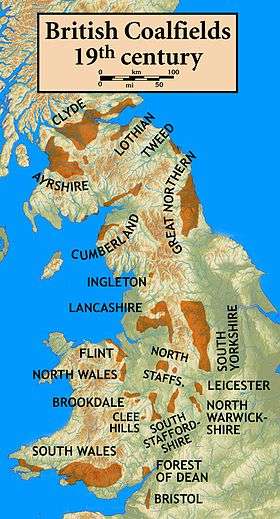Coalbrookdale Coalfield
The Coalbrookdale Coalfield is a coalfield in Shropshire in the English Midlands. It extends from Broseley in the south, northwards to the Boundary Fault which runs northeastwards from the vicinity of The Wrekin past Lilleshall. The former coalfield has been built on as the new town of Telford.

History
Coal-mining in the area is believed to have been undertaken by the Romans, as the coalfield lay on Watling Street.[1] Mining activity was first documented in the 13th and 14th centuries, when the monks at Buildwas Abbey were granted the right to coal and ironstone by Phillip de bethall.[2] Although the coalfield only covers an area of 20 square metres (220 sq ft),[3] it has been noted as being historically significant on account of its location with the ironstone seams, that allowed Abraham Darby I, in 1708 to make iron more efficiently using coke, rather than charcoal, thereby starting the Industrial Revolution.[4] The River Severn also allowed for delivery of goods made in his works in Coalbrookdale.[5]
During the late 16th and early 17th centuries, the Coalbrookdale Coalfield was second only to the North East Coalfield in terms of volume and it was producing 95% of the coal in the Shropshire area.[6]
By 1896, the Coalbrookdale Coalfield had over 80 mines operating in the district; whilst most of these worked coal, some also worked the bands of fireclay too.[7] Some of the fireclay were os such quality that they were used for the manufacture of pottery and clay tobacco pipes.[8] Not all of the mines were too deep, some were described as surface mines, but the deep-mining industry in the coalfield peaked in the mid-19th century,[9] with the last coal mine, Granville, being closed in 1979.[10] Surface mining (opencasting), has been more prevalent in the western edge of the coalfield around Lawley, Little Wenlock and north of the River Severn at Ironbridge.[11]
Geology
Coal-bearing strata are to be found across three synclines; the Donnington, Madeley and Coalport synclines whilst the majority of the coalfield is subject to intense faulting.[12]
The following coal seams are recognised:[13]
- Middle Coal Measures
- Top
- Double
- Flint
- Lower Coal Measures
- Best, Randle and Clod
- Lancashire Ladies
The coalfield extends from Broseley in the south west of the region to Lilleshall in the north east and is described as being roughly in a triangular shape.[14] Whilst it is thought that the coalfield extends towards, and into, the Staffordshire Coalfield, no mining for coal was undertaken east of the village of Shifnal.[15]
Modern day
With most of the coal mines worked out by the 1960s, the idea of a new town was born, and although it was originally called Dawley new Town, Telford sprang up over the old coalfield.[16] Mining continued into the 21st century, but was all of an opencasting nature.[17] The site at Granville Colliery was transformed into Granville Country Park.[18]
See also
References
- Brown 1979, p. 11.
- "Coalbrookdale Coalfield". shropshirehistory.com. Retrieved 5 March 2020.
- Birch, T W (June 1934). "Development and decline of Coalbrookdale Coalfield". Geography. Sheffield: Geographical Association. 19 (2): 114. OCLC 1043070391.
- "Engineering Timelines - Coalbrookdale Foundry". www.engineering-timelines.com. Retrieved 5 March 2020.
- "Abraham Darby, ironmaking pioneer". www.bbc.co.uk. Retrieved 5 March 2020.
- "The Mining Landscape - The Nine Men of Madeley Project - Explore Local Mining History in Madeley, Shropshire". www.ninemen.org. Retrieved 5 March 2020.
- "Peak District Mines Historical Society Ltd". projects.exeter.ac.uk. Retrieved 5 March 2020.
- Newsham, Hough & Morigi 2014, p. 16.
- Newsham, Hough & Morigi 2014, p. 22.
- Pevsner, Nikolaus & Newman, John (2006). Shropshire (2 ed.). London: Yale University Press. p. 16. ISBN 0-300-12083-4.
- Newsham, Hough & Morigi 2014, p. 26.
- Hamblin & Coppack 1995, p. 2.
- Hains, B.A. & Horton, A. (1969). British Regional Geology: Central England (Report) (3rd ed.). London: HMSO for British Geological Survey.
- Brown 1979, p. 12.
- Brown 1979, pp. 12–13.
- Walsh, Paul (8 August 2018). "Telford at 50: Could new towns offer a fresh start to millennials today?". The Guardian. Retrieved 5 March 2020.
- "Work starts at demo-hit mine site". BBC News. 13 October 2010. Retrieved 5 March 2020.
- "Granville Country Park | Shropshire Wildlife Trust". www.shropshirewildlifetrust.org.uk. Retrieved 5 March 2020.
Sources
- Hamblin, R J O & Coppack, B C (1995). Geology of the Telford and Coalbrookdale Coalfield (Report). Keyworth: British Geological Survey. ISBN 0-11-884-516-0.CS1 maint: ref=harv (link)
- Brown, Ivor (1979). "The Coalbrookdale Coalfield, Shropshire. - Mineral Working and Land Reclamation". Memoirs. Sheffield: Northern Mines Research Society. 11. OCLC 85089644.CS1 maint: ref=harv (link)
- Newsham, R; Hough, E & Morigi, A N (2014). Minerals Safeguarding Areas for Shropshire including Telford and Wrekin (PDF). shropshire.gov.uk (Report). Keyworth: British Geological Survey. Retrieved 5 March 2020.CS1 maint: ref=harv (link)